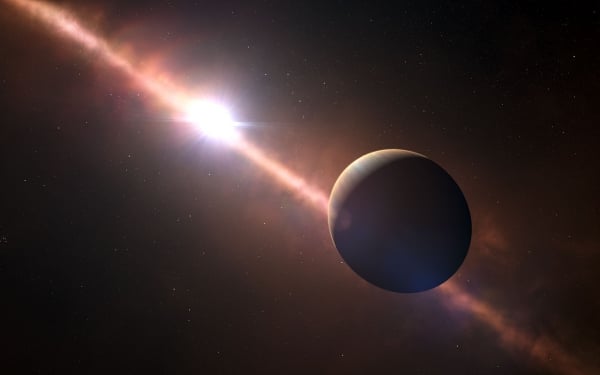This article is more than 1 year old
Actual spin doctors eye up alien world Beta Pictoris b: Young, hot ... and really fast
Eight-hour day planet ideal for cat-nappers
Alien world Beta Pictoris b is spinning so fast that its day lasts just eight hours as its equator whips around at almost 100,000km an hour.

Boffins – specifically doctors of astronomy – have managed to figure out the rotation rate of the exoplanet for the first time using the ESO's Very Large Telescope. They discovered the world is moving faster than any planet in our corner of the galaxy.
The planet is still hot from its formation, the boffins said.
“It is not known why some planets spin fast and others more slowly,” co-author Remco de Kok of the Leiden Observatory said in a statement. “But this first measurement of an exoplanet’s rotation shows that the trend seen in the Solar System, where the more massive planets spin faster, also holds true for exoplanets. This must be some universal consequence of the way planets form.”
Beta Pictoris b orbits the star Beta Pictoris, which is just 63 light years from Earth and can be directly imaged in the southern constellation of Pictor. The planet was discovered nearly six years ago and was one of the first to have a direct snapshot taken of it.
The massive world, which is 10 times bigger than Jupiter, orbits its host star at a distance of only eight times the Earth-Sun distance, making it the closest exoplanet to its sun ever to be pictured directly. The new spin measurement also makes it the fastest-spinning planet ever seen. Jupiter's equator goes around at less than half Beta Pictoris b's speed at 47,000kmph, while Earth is tootling along at a mere 1,700kmph. Jupiter completes its day in 9.9 hours.
To figure out the exoplanet's spin rate, the researchers used the Doppler effect on radiation in the atmosphere. The team picked out the molecular signal of carbon monoxide in the air and watched how it changed as the planet rotated.
“We have measured the wavelengths of radiation emitted by the planet to a precision of one part in a hundred thousand, which makes the measurements sensitive to the Doppler effects that can reveal the velocity of emitting objects,” said lead author Ignas Snellen, also from Leiden Observatory. “Using this technique we find that different parts of the planet’s surface are moving towards or away from us at different speeds, which can only mean that the planet is rotating around its axis."
The same effect is used in Doppler imaging, which maps the surfaces of stars and was recently used to reveal the surface of the brown dwarf Luhman 16B. In future, Beta Pictoris b's surface could be mapped for possible cloud patterns and large storms using the same techniques.
“This technique can be used on a much larger sample of exoplanets with the superb resolution and sensitivity of the European Extremely Large Telesecope (E-ELT) and an imaging high-dispersion spectrograph.
"With the planned Mid-infrared E-ELT Imager and Spectrograph (METIS) we will be able to make global maps of exoplanets and characterise much smaller planets than Beta Pictoris b with this technique”, said METIS principal investigator and co-author of the new paper, Bernhard Brandl.
The full study, "Fast spin of the young extrasolar planet β Pictoris b", was published in Nature. ®
